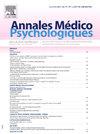卡普格拉斯综合征的历史--它是自然形成的吗?
IF 0.5
4区 医学
Q4 PSYCHIATRY
引用次数: 0
摘要
约瑟夫-卡普格拉斯(Joseph Capgras,1873-1950 年)和他的学生们在 1923 至 1924 年间首次描述了 3 个病例,他们将这种现象称为 "幻视"(Illusion des sosies),并很快将其命名为 "卡普格拉斯综合症"(Capgras's Syndrome,CS)。1923 年的第一例病例将这一现象定义为:患者无法获得一个人的身份,并且由于相似性得以保留,因此无法宣称她面对的是一个 "sosie"(替身)。这种解释仅限于一种猜测,即记忆中的形象和实际感知之间存在着不同的情感因素。接下来的两个病例更倾向于当时流行的心理动力学解释,这导致病例 3(病因是器质性的)误解了它的意义。之后,这种综合症在其第二故乡英国很早就为人所知,它将成为人脸识别研究方面的心理学家在认知神经精神病学的框架内进行单一解释的对象。精神病学特有的 "区域认识论 "的支持者以精神病和器质性病例之间的不连续性为名,对这种方法提出了质疑。通过对术语的反思,我们得出结论,CS既是一种自然的概念,也是一种实用的概念。本文章由计算机程序翻译,如有差异,请以英文原文为准。
Historique du syndrome de Capgras – est-il une forme naturelle ?
Joseph Capgras (1873–1950) and his pupils described between 1923 and 1924 the 3 first cases of a phenomenon that they called “Illusion des sosies” and quickly designated as Capgras’ syndrome (CS). The 1923 princeps case defined the phenomenon as coming from the impossibility for the patient to have access to the identity of a person and, because the resemblance was preserved, to declare that she dealt with a “sosie” (a double). The explanation was limited to the conjecture that there existed a different emotional factor between the memory image and the actual perception. The 2 following cases were more oriented towards the, then booming, psychodynamic explanations which lead in case 3, where the aetiology was organic, to misunderstand its interest. Afterwards, the syndrome which has been early known in the UK, its second chosen homeland will be the object, from psychologists specialists of face recognition studies, of unitarian explanations in the frame of a Cognitive neuropsychiatry. This approach is challenged in the name of a discontinuity between psychiatric and organic cases by supporters of a “regional epistemology” peculiar to psychiatry. A reflection about terminology concludes, in agreement with the concept of syndrome, that CS is both a natural and a practical kind.
求助全文
通过发布文献求助,成功后即可免费获取论文全文。
去求助
来源期刊

Annales medico-psychologiques
医学-精神病学
CiteScore
1.30
自引率
33.30%
发文量
196
审稿时长
4-8 weeks
期刊介绍:
The Annales Médico-Psychologiques is a peer-reviewed medical journal covering the field of psychiatry. Articles are published in French or in English. The journal was established in 1843 and is published by Elsevier on behalf of the Société Médico-Psychologique.
The journal publishes 10 times a year original articles covering biological, genetic, psychological, forensic and cultural issues relevant to the diagnosis and treatment of mental illness, as well as peer reviewed articles that have been presented and discussed during meetings of the Société Médico-Psychologique.To report on the major currents of thought of contemporary psychiatry, and to publish clinical and biological research of international standard, these are the aims of the Annales Médico-Psychologiques.
 求助内容:
求助内容: 应助结果提醒方式:
应助结果提醒方式:


